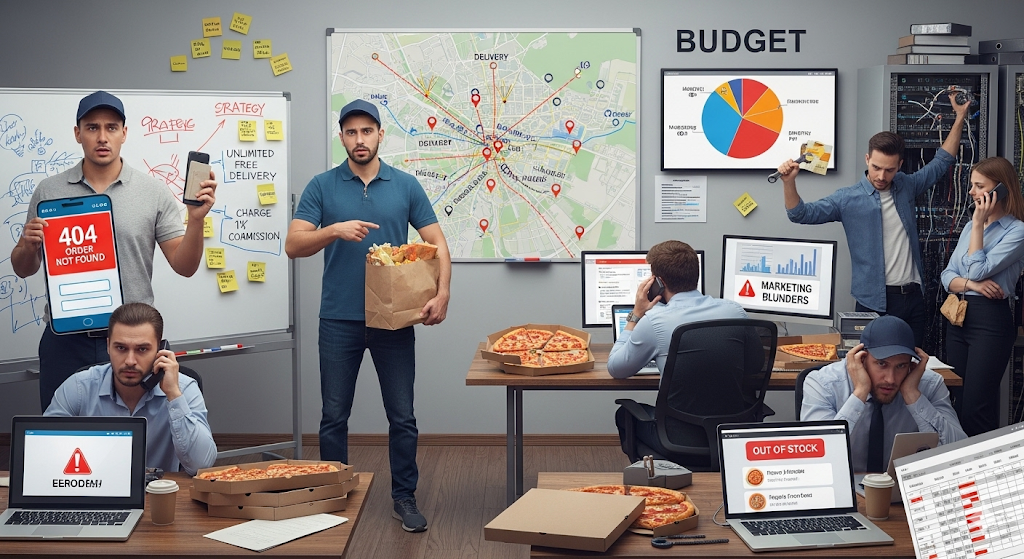5 Mistakes to Avoid When Building a Food Delivery Startup
The food delivery market has experienced unprecedented growth. For this particular sector, global revenues are projected to reach
$365 billion by 2030. However, despite this lucrative opportunity, many food delivery startups fail within their first two years. Most of the time the reasons simply were preventable strategic and operational mistakes. It is very important that these pitfalls are properly understood by food delivery entrepreneurs.
Today we present you with this comprehensive guide. This guide examines the most critical errors that derail food delivery ventures. We will also equip you with actionable strategies to avoid them. As you gain awareness of these common missteps, as a startup founder you can build more resilient and scalable platforms — the kind that is sure to capture market share and drive sustainable growth.
Mistakes To Avoid While Building A Food Delivery Startup
Here we are mentioning how to avoid making these mistakes while starting a food delivery business.
Mistake 1: Underestimating Technical Infrastructure Requirements
The Critical Role of Sturdy Platform Architecture
We have observed a pattern amongst food delivery entrepreneurs whose ventures have not succeeded. They entered the food delivery space with limited understanding of the complex technicalities needed to support a seamless user experience. As someone who is thinking of entering the market you are to be aware of the fact that underlying infrastructure must handle multiple stakeholders simultaneously. It should be able to handle customers browsing menus and restaurants processing orders along with delivery partners being able to coordinate logistics – all in real-time.
The technical foundation encompasses several critical components:
- real-time order tracking systems
- payment processing integration
- GPS-based delivery optimization
- inventory management for partner restaurants
- scalable database architecture that can handle peak demand periods
A poorly designed system will struggle under load. This can ultimately result in app crashes along with delayed orders, and frustrated users who quickly migrate to competitors.
Performance Benchmarks and Scaling Considerations
Industry data reveals that food delivery apps must maintain
99.9% uptime during peak hours. The page load times of the app must be under 3 seconds if they aim to prevent user abandonment. We have also observed that applications experiencing frequent downtime or slow performance see customer retention rates drop by up to 65% within the first month.
Successful platforms implement
microservices architecture. They enable independent scaling of different system components based on demand patterns. This approach allows businesses to optimize resource allocation and maintain consistent performance even during high-traffic periods like lunch rushes or major sporting events.
Rather than building everything from scratch, smart entrepreneurs leverage established solutions like one from
ClonifyNow – a food delivery app development company. The clone provides a comprehensive technical foundation with pre-built modules for all essential functionalities. This approach significantly reduces development time and eliminates many technical risks associated with custom builds.
Mistake 2: Inadequate Market Research and Competitive Analysis
A fundamental error many food delivery startups make is launching without thorough market research. Each and every geographic market has unique characteristics — local cuisine preferences, unique delivery expectations, price sensitivity, and competitive landscape dynamics. These varying characteristics directly impact success probability.
Effective market research involves analyzing demographic data, conducting customer surveys, studying competitor pricing strategies, and identifying underserved market segments. This intelligence informs critical decisions about target customer profiles, service area boundaries, restaurant partnerships, and marketing approaches.
Competitive Positioning and Differentiation Strategies
There are established players in the food delivery scene who hold significant market advantages through economies of scale, brand recognition, and network effects. New entrants must identify clear differentiation opportunities rather than attempting to compete directly on price or coverage area.
Successful differentiation strategies include:
- focusing on specific cuisine types
- targeting underserved geographic areas
- offering unique features like group ordering or dietary filtering
- providing superior customer service experiences
The key is identifying gaps in existing market coverage and developing compelling value propositions that resonate with target customers.
Data-Driven Market Entry Decisions
Market entry decisions should be supported by quantitative analysis rather than assumptions. Key metrics include:
- market size
- customer acquisition costs
- average order values
- delivery density
- competitive intensity
Markets with high customer acquisition costs and low order values often prove unprofitable for new entrants without significant capital backing.
Mistake 3: Poor Restaurant Partner Acquisition and Management
Building Strategic Restaurant Partnerships
Restaurant partnerships form the foundation of any food delivery platform. Many startups struggle with partner acquisition and retention. Effective partner acquisition requires understanding restaurant pain points and presenting compelling value propositions. Restaurants care about increasing revenue, accessing new customers, and streamlining operations. Platforms that demonstrate clear benefits – such as analytics, marketing support, or operational tools – achieve higher partner acquisition rates.
Commission Structure and Revenue Optimization
Commission pricing is a delicate balance between profitability and restaurant satisfaction. Excessive commission rates drive away quality partners, while insufficient rates compromise business viability. Industry standards typically range from 15-30% with variations based on service levels and partnerships.
Smart platforms implement
tiered commission structures that reward high-performing partners with reduced rates, encouraging increased engagement and long-term partnerships.
Operational Support and Technology Integration
Restaurants require ongoing support to maximize their performance. This includes:
- training staff on order systems
- optimizing menu presentations
- implementing quality control processes
- providing marketing guidance
Technology integration is also critical, with restaurants preferring platforms that integrate with POS systems, inventory tools, and kitchen displays. Comprehensive integration reduces friction and improves satisfaction.
Mistake 4: Inefficient Delivery Logistics and Driver Management
Delivery logistics represent one of the most complex operational challenges. Inefficient routing algorithms, poor driver allocation, and inadequate demand forecasting can lead to delays, increased costs, and poor experiences.
Successful platforms implement sophisticated logistics optimization systems that account for order density, driver availability, traffic, restaurant prep times, and customer preferences.
Driver Recruitment and Retention Strategies
The gig economy nature of delivery work creates ongoing challenges in recruitment and retention. High turnover increases costs and reduces service quality. Effective driver management involves:
- competitive compensation
- flexible scheduling
- performance incentives
- comprehensive support systems
Technology Solutions for Logistics Excellence
Advanced analytics and machine learning can forecast demand, optimize driver positioning, and reduce delivery times. Platforms utilizing proven solutions, such as ClonifyNow’s delivery management system, can adopt these capabilities faster and with less risk.
Mistake 5: Inadequate Customer Acquisition and Retention Strategies
Building Effective Marketing Funnels
Customer acquisition costs can be substantial, and many startups fail to create effective strategies. Successful acquisition requires multi-channel approaches such as digital marketing, referrals, partnerships, and targeted promotions. The goal is to identify channels generating the highest quality users with strong retention rates.
Retention Optimization and Loyalty Programs
Retention is more cost-effective than acquisition. Increasing retention by just 5% can increase profits by 25-95%. Effective retention strategies include:
- personalized recommendations
- loyalty programs
- proactive customer service
- continuous app improvements
Platforms should track user analytics to detect churn signals and intervene early.
Leveraging Data Analytics for Growth
Modern food delivery startups generate vast user data. However, many fail to use analytics effectively. Comprehensive platforms track:
- customer acquisition costs
- lifetime value
- order frequency
- geographic performance
- competitive intelligence
Data-driven decisions improve performance across all metrics.
Building Success with Proven Solutions
The complexity of building from scratch has led many entrepreneurs to adopt proven solutions.
ClonifyNow’s UberEats clone provides a comprehensive foundation covering technical infrastructure, restaurant management, delivery logistics, and customer engagement.
By leveraging established platforms, entrepreneurs can focus on customization and growth strategies rather than reinventing the basics. This improves success probability and reduces time-to-market.
Transform Your Food Delivery Vision Into Reality
The food delivery market continues to expand, creating opportunities for innovative entrepreneurs who avoid pitfalls and adopt strategic approaches. Success requires planning, sturdy technology, and market understanding.
If you are planning to launch a food delivery startup with confidence,
ClonifyNow’s UberEats clone app eliminates technical risks while offering flexibility for differentiation. Contact ClonifyNow today to explore how their platform can accelerate your journey to success.
Frequently Asked Questions
How long does it typically take to achieve profitability in food delivery?
Food delivery startups typically require
18-36 months to achieve profitability. This varies by market conditions, competition, and efficiency. Platforms with higher order frequency (3+ orders per user per month) and delivery costs below 15% of order value reach profitability faster.
What are the most important metrics to track for food delivery startup success?
Critical metrics include:
- customer acquisition cost (CAC)
- customer lifetime value (CLV)
- monthly active users
- average order value
- delivery time performance
- customer retention rate
- restaurant partner satisfaction
- unit economics per delivery
Successful platforms maintain CAC-to-CLV ratios of
1:3 or better, delivery times under 35 minutes, and monthly retention rates above 25%.
How do I differentiate my platform from established competitors like UberEats and DoorDash?
Differentiation strategies focus on underserved markets or unmet needs. Examples include:
- specializing in healthy food options
- targeting suburban areas
- offering group ordering
- focusing on local restaurant partnerships
- providing superior customer service
The key is to identify genuine gaps and build value propositions that resonate with customers while creating sustainable advantages.








 +91-9464826889
+91-9464826889